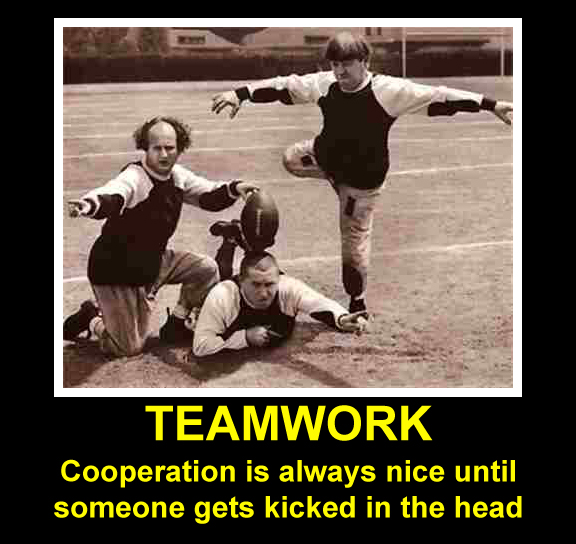Edit: Be sure to check out Saturday's post, S is for Spell Selection! I've noticed my readership dips a bit on the weekends, so I want to make sure those posts get some lovin' too.
A typical tabletop game like D&D tends to tell the tale of a team of... heroes. As such, the game is structured so that its default mode works best when each member of a group takes on a particular role. 3rd edition D&D is based around an assumed group of four players, though scaling the group size up or down is certainly possible. I personally believe that 5 players and a GM is ideal. This post is a mixture of talk of teamwork, tactics and thinking outside the box.
Within the 4-person structure, the most basic group breaks down as follows: a fighter or barbarian to handle the fighting up front, a rogue to handle scouting or and to disarm traps and open locks, a wizard or sorcerer to chuck spells from a distance and a cleric to provide healing and act as a support fighter and/or spell-caster.
I have noticed that gameplay and growth as a player tends to progress similarly to a kid learning to play a sport. At first, it’s a bit of bunch ball. Everyone wants to be the one to deliver the killing blow. At this stage, teamwork tends to be fairly rudimentary. The cleric will heal others between fights, or if someone whines that they’re about to die. The spell-caster typically stays near the edge of the fight, sending spells in beyond the reach of the enemy. The rogue might try to flank with the fighter to get some bonus backstab damage, but that’s about it. Otherwise, the game remains pretty hack and slash, with everyone hacking and slashing as they feel is best.
After a while, however, a group hopefully starts to work out some more distinct tactics that highlight each character’s strengths. In the game I run, for example, the first thing that happens during any major fight is that the sorceress or wizard drops a haste spell on the group to speed up their movement and attacks. In the last game I played, my wizard developed a magical equivalent to the Wolverine/Colossus hurling attack. I would open a dimension door for the barbarian to step through and get at the chewy center of an enemy formation.
Even when a group starts putting together their battle routine, the temptation to fall into free-for-all hack-and-slash can remain strong. After all, because D&D is a turn-based game in which each round of actions can take 10 minutes to half-an-hour or more, and because a fight might only last two or three rounds, every player wants to feel like his or her character contributed in some way. Nothing feels worse than having your character reach the fight just as it’s ending, or whif every single attack due to unlucky dice.
Sometimes an encounter is just not meant to highlight a particular character in one-on-one combat. Maybe the GM wants to give the cleric a chance to nuke a bunch of zombies with her divine righteousness. This could very-well frustrate the rogue who can’t get backstab damage against the undead. In such situations, it is easy to become frustrated as a player. However, such times might also be a great chance to get creative and move beyond the desire to deal as much damage as possible with your weapon in hand. Think outside the box, think how you can assist your team. For example, during a fight in a wooden building, the pyromancer might get annoyed that the GM is preventing her from hurling her favorite fireballs. It might be a perfect opportunity, however, to fly up to the rafters and start cutting down chandeliers onto badguy’s heads, or to kneel down behind the guy who has cornered the rogue so he can push him over for some extra stabby goodness.
A good GM should always try to foster such creative thinking. After all, it’s much more fun to run a chandelier-swinging bar brawl than a toe-to-toe hit, return hit, slugfest. So, when your hero finds his or herself outside of the spotlight, either find a new spotlight, or try to find a way to make someone else’s spotlight a little brighter.


It's been ages since I last played D&D. I used to roll a new thief character every time I played so I could make him take all the chances over my cool character. lol
ReplyDeleteSend in the halfling! Wise choice. Thanks for stopping by!
Delete